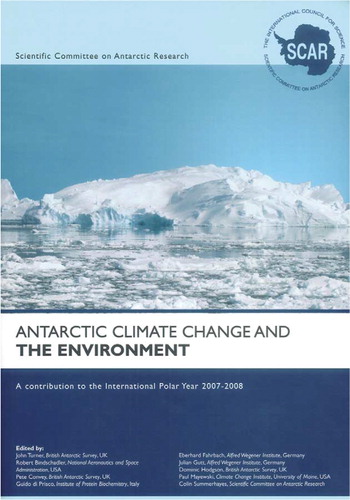Review of Antarctic climate change and the environment, edited by John Turner, Robert Bindschadler, Pete Convey, Guido di Prisco, Eberhard Fahrbach, Julian Gutt, Dominic Hodgson, Paul Mayewski & Colin Summerhayes (2009). Cambridge: Scientific Committee on Antarctic Research, Scott Polar Research Institute. 526 pp. ISBN 978-0-948277-22-1.
This impressive report from the Scientific Committee on Antarctic Research (SCAR) covers nearly 400 pages of text with more than 100 additional pages of references. Under the clearly very able leadership of John Turner of the British Antarctic Survey, the nine editors have coordinated more than 100 contributors to produce a comprehensive review of our knowledge of Antarctica's climate up to 2007.
The report can be seen as a companion to the Arctic climate impact assessment published in 2005. Partly as a result of that assessment, SCAR decided to make a similar review for the Antarctic region. The printed report, along with its electronic companion, was ready for the 50th anniversary of the signing of the Antarctic Treaty, on 1 December 2009, and the important findings were also presented at the 32nd Antarctic Treaty Consultative Meeting in April that year.
Given its area, the Antarctic has been, and remains, the least investigated part of the Earth. This report shows that, even so, there have been large forward strides during recent decades in our understanding of the climate processes in our southernmost regions. One striking result is the demonstrated correlation between reduced ozone in the upper atmosphere and cooling, offsetting the general global warming that is being observed in most global regions over the past decades.
Climate research, in the sense we know it today, was not high on the SCAR agenda in the early years of the organization. Short meteorological records were available, but there was only one long record—from Orcadas, the Argentinean station in the South Orkney Islands—so there were no observation records to use for climate deductions. And “palaeoclimate” was related to geological timescales. The review shows that now there are about two dozen multi-decadal records from around the continent that allow at least some conclusions on changes in wind, temperature and precipitation. The only strong statistical changes seem to be observed in parts of the Antarctic Peninsula area, which show a marked warming.
However, questions about the Antarctic climate were asked many decades ago, even if they could not always be answered. The 1949–1952 Norwegian–British–Swedish Maudheim expedition, arguably the first science-based expedition to Antarctica, was initiated by Prof. Hans W:son Ahlmann to answer: “Is the climate changing in the Antarctic, as evidenced by changes in glacier extent?” He formulated this question after studying aerial photographs and seeing what might be old moraines. A number of illustrious scientists produced climate-related results on that expedition.
Today, hundreds of groups around the world are researching Antarctic climate issues. Many are evaluating the mass balance of glaciers in Antarctica and their contribution to changing sea level. This is very different from the time I became involved in SCAR glaciology. In the 1970s the ice masses were thought to be quite stable, to such an extent that some proposed the ice sheet as a repository for radioactive waste. The demonstration of subglacial waterways and the realization of possible rapid changes in ice dynamics have long since squashed that idea.
That Antarctic glaciers can be dynamic even on yearly timescales has changed our view of the interactions of ice sheets, oceans, climate and the long-term prospects for sea level. The report shows that the prevalent view now is that the ice masses of Antarctica will contribute markedly to a total of 1.4 m sea level rise by the end of this century. Some modelling studies indicate that the snowfall over the continent will increase in warmer climates, but so far there are no clear answers as to whether this part of the ice-sheet mass balance is changing.
The most significant climate results coming from the glaciology studies in the Antarctic are related to climate data from the ice sheet. The Antarctic ice-core records are the longest such records available, giving detailed climate information for up to 800 000 years. The volume discusses some of this science, but this is a subject that I believe should have been given more space.
The review seems very comprehensive with regards to the literature after 1990 and gives many results in great detail. For the benefit of the non-specialized reader I suggest an even greater effort at syntheses would have been useful, though I recognize that scanty, patchy data can make it unrealistic to produce syntheses for climate questions for the whole continent. In this connection, the research efforts conducted during the International Polar Year from 2007 to 2009 should be a boost, especially as this large-scale international initiative greatly multiplied the quantity of field observations in areas of the Antarctica not commonly visited.
For economical reasons, the illustrations in the printed edition of Antarctic climate change and the environment are in black and white. Because full colour is necessary to appreciate some of the figures, I strongly recommend that readers obtain the colour electronic edition, which can be downloaded for free at this website: http://www.scar.org/publications/occasionals/ACCE_25_Nov_2009.pdf.
